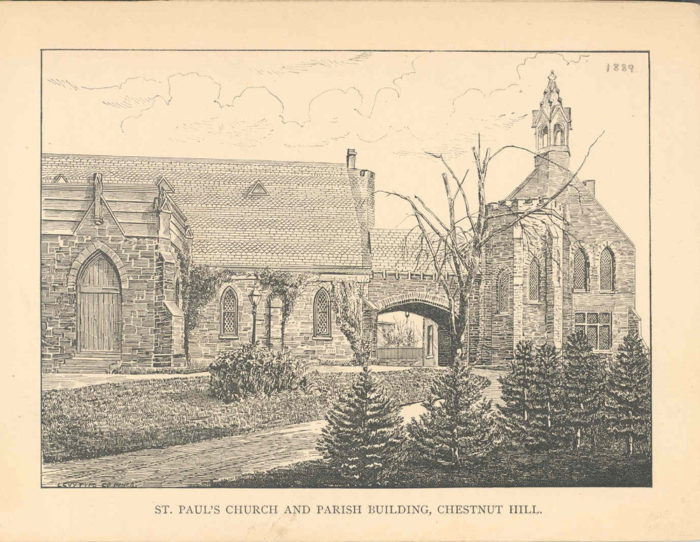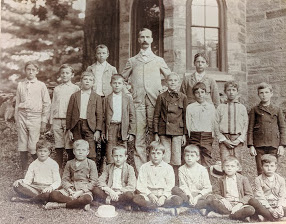Our History

“Ten well-dressed ladies and nine gentlemen” first gathered in the meeting room of the newly built Chestnut Hill Railroad station on June 18, 1855. They were there to “build a Christian community.” That community became St. Paul’s Episcopal Church Chestnut Hill and was admitted to the Diocese of Pennsylvania less than a year later.
The church sits on a tract of land that was purchased in 1856. In the same year a Chapel was built on the site by John E. Carver.
 In 1863 Rector William Hobart Hare wrote to our Sunday school children from Minnesota where an uprising of Sioux Indians had just been quelled. “There is a war raging in this state against them.” He concluded his letter, “They (the Sioux people) now call upon you, my dear boys and girls, for help…”
In 1863 Rector William Hobart Hare wrote to our Sunday school children from Minnesota where an uprising of Sioux Indians had just been quelled. “There is a war raging in this state against them.” He concluded his letter, “They (the Sioux people) now call upon you, my dear boys and girls, for help…”
In the middle of the night on April 9, 1865 news first reached Chestnut Hill of the surrender of General Robert E. Lee at Appomattox Court House. The little bell of our original Chapel rang out the good news of peace. The bell still sits in place ready to ring out “Peace on Earth.”
The cornerstone of the current church was laid in 1928. The ceiling of the church is built like a boat, symbolic of the Ark and the boat of the Fishermen. The altar faces east, and the rose window is located to the west. The church is rich with ornamental wood carvings, including an elaborate reredos and many angels that soar overhead. The carvings in the altar rail include: grapes (the symbol of the sacrament of Holy Communion), pelicans (the symbol of the atonement of Jesus), and the pomegranate (the symbol of resurrection). Notable local craftsmen contributed stonework, ironwork, and stained glass windows.
In 1945, St. Paul’s sixth rector, George Trowbridge, became the second president of the Philadelphia Fellowship Commission, dedicated to fighting racial and religious prejudice. He invited Eleanor Roosevelt to St. Paul’s in 1949 to receive the first National Fellowship Award from the Commission.
In 1947, seven years before “Brown vs. the Board of Education,” our organist, Thomas Dunn, hired an African-American soprano for our church choir. Dunn went on to become director of the Handel and Haydn Society.
In 1989, St. Paul’s began rehabbing buildings in East Germantown. “St. Paul’s Rehabbers” incorporated itself in 1993 as Habitat for Humanity, Germantown. This organization is now part of Habitat for Humanity, Philadelphia.
Throughout its history St. Paul’s has been served by remarkable priests and laypersons, people who made contributions to the community, to the diocese, and to the national church. Many St. Paulites have served the diocese actively as members of Standing Committee, at Episcopal Community Services, and on many other diocesan committees. Three members of the parish have served in roles as the diocese’s chancellor and treasurer.
Three of Saint Paul’s 11 rectors – the Rt. Revs. William Hobart Hare, Malcolm Endicott Peabody and James Russell Moodey – have gone on from St. Paul’s to serve as bishops. One assistant rector, Mary Douglas Glasspool, who was ordained priest at St. Paul’s in 1982, became the first openly lesbian woman to be elected a bishop in the Episcopal Church.
During our history, St. Paul’s has been a leader in and responsive to the church’s changes as they occurred. We have a long history of including women in important leadership roles.
In the early 1970s the parish used the experimental liturgies that led to the development and passage of the 1979 Book of Common Prayer.
In June 2014, almost immediately after the Commonwealth of Pennsylvania approved same-gender marriage, St. Paul’s became one of the first, if not the first, parish in the diocese to perform a same-gender wedding.
Our parish continues to serve God in the spirit created in that railroad station all those years ago.
To celebrate the parish sesquicentennial in 2006, a history of St. Paul’s was published: A Parish Journey, 1856-2006, by David R.Contosta.
